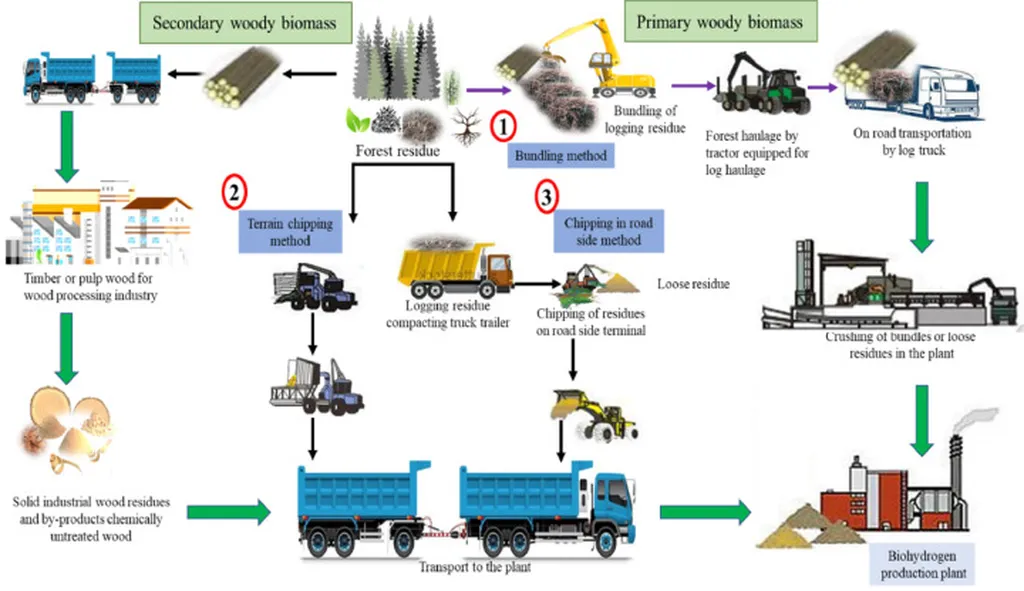In a groundbreaking study published in the journal *Applications in Energy and Combustion Science* (translated from Chinese as *应用能源与燃烧科学*), researchers have outlined a potential roadmap for achieving a sustainable green energy supply and carbon sequestration in the transport sector by 2060. The study, led by Aqib Zahoor from the International Joint Research Center for the Control and Prevention of Environmental Pollution on Tropical Islands of Hainan Province, highlights the transformative potential of biohydrogen produced from agricultural and forest residues.
The research leverages the Traffic Emission Evaluation Model of Project (TEEMP) to assess current and future technologies aimed at reducing carbon emissions. The findings reveal that in 2024, cumulative CO2 emissions from the forest and agricultural sectors were 3.5 billion metric tonnes (BMt), while the transportation sector contributed 8.47 BMt. This stark data underscores the urgent need for innovative solutions to curb emissions.
Zahoor and his team estimate that globally, about 5–10 gigatonnes (Gt) of biomass residues are technically and economically recoverable each year, primarily from China, India, the U.S., Russia, and Europe. These residues hold the potential to produce roughly 40–60 exajoules (EJ) of bioenergy annually. Instead of burning these wastes in fields—a practice that contributes significantly to greenhouse gas emissions—the study advocates for collecting and converting these residues into biohydrogen. This biohydrogen could then serve as a fossil fuel replacement, drastically reducing CO2 emissions.
“By collecting agricultural and forest waste residues, we can produce substantial amounts of biohydrogen,” Zahoor explains. “This approach not only reduces carbon emissions but also provides a sustainable energy source for the transport sector.”
The study highlights that biological pre-treatment and dark-photo fermentation are well-established techniques for producing high-quality biohydrogen due to their controllability and low energy consumption. Experimental findings indicate that collecting 1840 million tonnes (Mt) of agricultural waste and 927 Mt of forest waste residues could produce 15,460 kilotonnes (Kt) and 929 Kt of biohydrogen, respectively. This would help achieve a significant reduction in carbon emissions—85.13 Mt from agriculture and 57.75 Mt from forestry by 2040.
However, the path to sustainable biohydrogen production is not without challenges. The study identifies collection, transportation, and management of biomass residues as critical hurdles. Overcoming these challenges will require the development of supportive policies, implementation of laws, government and organizational training, satellite monitoring, and electronic media campaigns.
“The bottom-up accounting framework scenario reflects the overall possibilities of CO2 emissions reduction from 9.699 BMt to 0.03 BMt by 2010 to 2060,” Zahoor notes. “This can be achieved by stopping the open field burning of waste residues and using biohydrogen as an alternative to fossil fuels.”
The implications of this research are profound for the energy sector. By harnessing biohydrogen, the transport sector could achieve zero carbon emissions, contributing to global climate goals. The study’s findings offer a compelling case for investment in biohydrogen technology and infrastructure, positioning it as a key player in the future of sustainable energy.
As the world grapples with the urgent need to reduce carbon emissions, this research provides a promising roadmap for achieving a greener, more sustainable future. The study’s insights could shape future developments in the field, driving innovation and investment in biohydrogen production and utilization.

